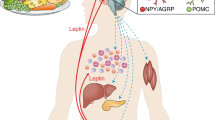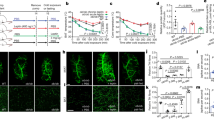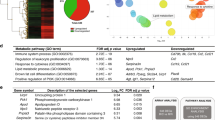Abstract
To study the potential role of the ob gene pathway in childhood obesity, we have investigated leptin mRNA levels in s.c. adipose tissue obtained from nonobese prepubertal children (n = 20), obese nonsyndromal children (n = 6), and children with Prader-Willi syndrome (n = 6) by in situ hybridization histochemistry. We have also investigated the fasting serum leptin levels in such children. Compared with nonobese children, leptin mRNA expression was higher both in children with Prader-Willi syndrome and in children with nonsyndromal obesity (p < 0.01). Furthermore, the serum leptin levels were also significantly higher in both children with Prader-Willi syndrome and nonsyndromal obesity compared with the nonobese children (p < 0.001). However, no significant differences in adipose tissue leptin mRNA or serum leptin levels were observed between children with Prader-Willi syndrome and nonsyndromal obese children. As expected both fasting serum leptin levels and leptin mRNA expression levels correlated to body mass index (rs = 0.80 and 0.73, respectively, p < 0.005). No difference in leptin expression between Prader-Willi syndrome and nonsyndromal childhood obesity could be revealed in the present study. However, differences in the hypothalamic response to leptin between the two forms of obesity cannot be excluded.
Similar content being viewed by others
Main
PWS is the most common syndromal cause of human obesity. It is a complex multisystem disorder caused by a paternal deletion or maternal disomy of chromosome 15q11-13(1), and is characterized by perinatal hypotonia with sucking and feeding difficulties, hypogonadism, later hyperphagia leading to obesity, short final stature, psychomotor developmental delay, behavioral abnomality, and dysmorphic features(2). Obesity is the rule in patients with uncontrolled PWS, because their caloric intake is high and their energy expenditure is low(3). It has been suggested that the hypothalamic dysfunction observed in these subjects may lead to lack of satiety, and thereby an increased appetite.
Satiety is one of the most important factors controlling energy intake. The identification of the ob gene(4) and its corresponding product leptin as well as the leptin receptor(5) has resulted in a large number of reports that have demonstrated the great pathophysiologic importance of the leptin signaling pathway for both eating behavior and energy balance in rodents, whereas the physiologic role of this system in man is less well known(6). The ob gene is highly expressed in fat cells from which circulating leptin is secreted. This protein is presumed to mediate signals from adipose tissue to the brain, thereby acting as a lipostat mechanism through modulation of satiety signals(7). If no leptin is produced, satiety is not obtained, and the subject consequently continues to eat. In obese humans, however, increased gene expression and elevated circulating levels of apparently normal leptin have been observed(8–13). The latter might indicate that central resistance to leptin is of importance for the development and/or maintenance of human obesity. For this reason, PWS with its hypothalamic dysfunction is a particularly interesting disorder for studies of the role of the leptin system in man. We have measured the human ob gene expression in s.c. adipose tissue and the corresponding serum leptin levels in children with PWS, children with nonsyndromal obesity, and nonobese children to reveal possible mechanisms explaining differences in the body weight regulation between these groups.
METHODS
Subjects. Six prepubertal children (one girl and five boys, aged 4.3-12.7 y, BMI 0.3-6.1 SDS) with clinically and molecular-genetically verified PWS and more than 8 points of the internationally accepted PWS scoring system(14), six nonsyndromal obese children (one girl and five boys, aged 10-16 y, BMI 3.2-8.6 SDS), and 20 healthy prepubertal nonobese children (five girls and 15 boys, aged 0.2-12 y, BMI -1.9 to 1.8 SDS) were included for mRNA measurement. Fasting venous blood samples for determination of serum leptin were obtained from the obese children, the children with PWS, and 23 healthy nonobese prepubertal children (three girls and 20 boys, aged 5.5-14.6 y, BMI <2 SDS)). No significant difference in age was found between the obese (PWS and nonsyndromal) children and the nonobese children (9.7 y ± 3.7 versus 11.4 y ± 3.3). Except for PWS, obesity, or hernia inguinale, the children had no apparent disease and took no medication.
Adipose tissue biopsies. Children with PWS and nonsyndromal obesity had abdominal s.c. biopsies taken after local anesthesia with prilocaine. Adipose tissue from nonobese children was obtained from elective inguinal hernia surgery. The children had been fasting overnight, and the biopsies were taken in the morning. The adipose tissue specimens, which ranged from 0.2 to 0.5 g, were immediately frozen unfixed on dry ice or liquid nitrogen and stored at -70 °C until sectioned.
The study was approved by the Ethics Committee of the Karolinska Institute, Stockholm, Sweden. All parents gave informed consent to participation in the study.
In situ hybridization. One oligonucleotide complementary to nucleotides 122-169 (ob 1) of the human ob sequence(4) and one γ-actin oligonucleotide, complementary to nucleotide 325-372, were synthesized, purified, and labeled as previously described(9). The γ-actin probe was used to secure, first, that the mRNA was of equally good quality in all examined tissue samples and second, that changes in leptin mRNA were specific for the latter gene.
Adipose tissue samples from all 32 human subjects were analyzed with respect to ob and γ-actin expression in s.c. fat. Adipose tissue was cut at 20-μm thickness in a cryostat, thawed onto electrically charged Fisher probe on + slides (Fisher Biotech), and processed for in situ hybridization as previously described(15).
Autoradiographic(14) C microscale strips (Amersham Corp.) ranging from 2 to 98 nCi/g were used as standards by coexposure with the tissue sections on Amersham Hyperfilm, B-max, X-ray film. Samples from three PWS, three other obese, and three nonobese subjects were mounted on each slide to simplify the comparison between the different groups and between different individuals. In all subsequent steps, slides were processed together, effectively handled as a single batch through hybridization, washes, autographic exposure, and computerized image analysis. Three sections from each individual tissue were included in the analysis. The computer image was performed as previously described(9).
Leptin assay. The circulating plasma leptin levels were determined with a commercially available human leptin RIA kit (Linco Research Inc., St. Charles, MO). The antibody was raised against highly purified human leptin, and both the standard and tracer were prepared with human leptin. The samples were run in duplicate. All samples were in the detection range of the kit, i.e. 0.5-100 ng of leptin/mL, and the intra-and interassay coefficients of variance were 3.9 and 4.7%, respectively.
Statistical analysis. Values are given as the mean ± SD and median ± range. The two-tailed unpaired t test, ANOVA, and single regression analysis were used for statistical comparisons.
RESULTS
BMI in nonsyndromal obese children was significantly increased compared with children with PWS (5.2 SDS ± 1.9 versus 2.5 SDS ± 2.1, p = 0.05). BMI of children with PWS and nonsyndromal obesity was significantly increased compared with nonobese children (3.8 SDS ± 2.4 versus -0.8 SDS ± 1.0, p ≤ 0.001).
The individual leptin mRNA values in s.c. adipose tissue from children with PWS, nonsyndromal obesity, and nonobese children are depicted in Figure 1A. To adjust for minor differences in general mRNA content in different preparations, leptin mRNA is expressed as the ratio between leptin mRNA and γ-actin mRNA, which has been shown to be expressed to the same extent independently of the BMI(10). The leptin mRNA expression ratio in adipose tissue from PWS and nonsyndromal obese children was in a similar range (103-246% and 106-171%, respectively) and was significantly increased compared with the leptin mRNA expression ratio in adipose tissue from nonobese children. Leptin mRNA levels in nonobese children varied considerbly (25-94%). Four of the 20 nonobese children had an elevated leptin mRNA expression ratio. These four children were the oldest ones in the nonobese group (5-12 y of age). We have investigated the parental BMI of all nonobese children. In three of these four children the parental BMI of one or both parents was >27 kg/m2, whereas the parental BMI of the others was in the normal range.
(A) Individual leptin mRNA expressed in children with PWS, nonsyndromal obese children, and nonobese children. The values of each subject is the mean value of three adipose tissue sections processed in one in situ hybridization experiment. The median and the range are expressed for the different groups of children. There was a significant difference between children with PWS/nonsyndromal obesity and nonobese children (p < 0.01). (B) Individual serum leptin levels of children with PWS, children with nonsyndromal obesity, and nonobese children were determined by a commercially available kit. The different group values are median and range. The levels of serum leptin (S-Leptin) were significantly higher in children with PWS and nonsyndromal obesity than in nonobese children (p < 0.001). (C) Simple linear regression analysis showing the correlation between serum leptin levels and BMI SDS in the total material of children with PWS and nonsyndromal obesity and in nonobese children (rs = 0.80, p < 0.005).
Fasting serum leptin levels in children with PWS and nonsyndromal obesity were not significantly different (Fig. 1B). However, compared with nonobese controls, the serum leptin levels in both children with PWS and nonsyndromal obesity were significantly higher (32.6 ng/mL ± 20.8 versus 4.9 ng/mL ± 3.1, p < 0.001). As depicted in Figure 1C, serum leptin also correlates to BMI SDS (r = 0.80 and p < 0.005) as previously shown in childhood studies on leptin(12, 13). In the present study a correlation was found between leptin mRNA and BMI (r = 0.73 and p < 0.001). Furthermore, leptin mRNA was found to correlate to age at least in nonobese children (r = 0.62 and p = 0.004). No difference in leptin mRNA expression or serum leptin levels was found between genders.
DISCUSSION
This study confirms that obesity is associated with increased leptin mRNA and serum leptin levels(9–13). Furthermore, serum leptin levels were correlated to BMI when both lean and obese children were included. On the other hand, no significant correlations were observed between serum leptin levels and BMI or between serum leptin and leptin mRNA when the obese children were studied separately. This is in contrast to previous reports in adult subjects(12) and may be due to the size of the material. However, differences in leptin regulation between children and adults cannot be completely excluded; therefore, it is possible that circulating leptin to a lesser extent is regulated at the transcriptional level in children. From the present data we cannot conclude whether the higher ob gene expression in the obese children is due to a higher transcriptional rate or to a slower mRNA turnover. It still remains to be demonstrated whether leptin in man is involved in the regulation of satiety and, if so, to what extent total plasma levels or leptin levels in the cerebrospinal fluid are of importance. At least in adult obesity, data have been reported that strongly suggest a blunted transport of leptin over the blood-brain barrier(16, 17). From previous knowledge about PWS it is tempting to speculate that this disorder would be due to a specific defect in the hypothalamic satiety center and that the mechanism underlying obesity would be different from that in nonsyndromal obesity. However, in the present study no significant differences in leptin mRNA and serum leptin levels were observed between these two forms of obesity. From the present data, it seems likely that neither PWS nor nonsyndromal childhood obesity is caused by a defective regulation of fat cell leptin expression. The feedback response to a putative leptin receptor resistance seems to be similar in these two disorders, but the mechanisms behind the resistance may of course be different in PWS compared with nonsyndromal obesity. The hypothalamic mechanism behind the weight-regulating effects of leptin are yet only partly revealed. However, several reports indicate that neuropeptide Y may have a major role in mediating leptin signals(6, 7, 18).
Nevertheless our mRNA and serum leptin data are compatible with an overstimulation of the ob gene (directly or indirectly) due to a defective stimulation of the hypothalamic satiety leptin receptor itself, in analogy with the db mouse(19, 20). In four of 20 nonobese children (one girl and three boys) relatively high leptin mRNA expression was observed. Interestingly, in contrast to the others, three of these four children had a hereditary predisposition for moderate obesity. However, they were also the oldest ones in the nonobese group. The elevated leptin mRNA expression in these nonobese children might therefore reflect either a relative “leptin resistance” in prepubertal children, as previously discussed by other authors(13), or reflect a large variation of leptin mRNA expression in nonobese children.
Abbreviations
- BMI:
-
body mass index
- SDS:
-
SD score
- db:
-
diabetes mutant
- ob:
-
obese gene
- PWS:
-
Prader-Willi syndrome
References
Knoll JHM, Nicholls RD, Magenis RE, Graham JM Jr, Lalande M, Latt SA 1989 Angelman and Prader-Willi syndromes share a common chromosome 15 deletion but differ in parental origin of the deletion. Am J Genet 32: 285–290.
Cassidy SB 1984 Prader-Willi syndrome. Curr Probl Pediatr 14: 1–55.
Hill JO, Kaler M, Spetalnick B, Reed G, Butler MG 1990 Resting metabolic rate in Prader-Willi syndrome. Dysmorphol Clin Genet 4: 27–32.
Zhang Y, Proenca R, Maffei M, Barone M, Lori L, Friedman JM 1994 Positional cloning of the mouse obese gene and its human homologue. Nature 372: 425–432.
Tartaglia L, Dembski L, Weng X, Deng N, Culpepper J, Devos R, Richards GJ, Campfield LA, Clark FT, Deeds J, Muir C, Sanker S, Moriarty A, Moore KJ, Smutko JS, Mays GG, Woolf EA, Monroe CA, Tepper RI 1995 Identification and expression cloning of a leptin receptor, OB-R. Cell 83: 1263–1271.
Lonnqvist F 1996 The obese (ob) gene and its product leptin-a new route toward obesity treatment in man. QMJ 89: 327–332.
Rohner-Jeanrenaud F, Jeanrenaud B 1996 Obesity, leptin and the brain. N Engl J Med 344: 324–325.
Considine RV, Considine EL, Williams CJ, Nyce MR, Magosin SA, Bauer TL, Rosato EL, Colberg J, Caro JF 1995 Evidence against either a premature stop codon or the absence of obese gene mRNA in human obesity. J Clin Invest 95: 2986–2988.
Lönnqvist F, Arner P, Nordfors L, Schalling M 1995 Overexpression of the obese (ob) gene in human obese subjects. Nat Med 1: 950–953.
Hamilton BS, Paglia D, Kwan AYM, Deitel M 1995 Increased obese mRNA expression in omental fat cells from massively obese humans. Nat Med 1: 953–956.
Maffei M, Halaas J, Ravussin E, Pratley RE, Lee GH, Zhang Y, Fei H, Kim S, Lallone R, Ranganathan S, Kern PA, Friedman JM 1995 Leptin levels in human and rodent: Measurement of plasma leptin and ob RNA in obese and weight-reduced subjects. Nat Med 1: 1155–1161.
Considine RV, Sinha MK, Heiman ML, Kriauciunas A, Stephens TW, Nyce MR, Ohannesian JP, Marco CC, McKee LJ, Bauer TL, Caro JF 1996 Serum immunoreactive-leptin concentrations in normal-weight and obese humans. N Engl J Med 334: 292–295.
Hassink SG, Sheslow DV, deLancey E, Opentanova I, Considine RV, Caro JF 1996 Serum leptin in children with obesity: Relationship to gender and development. Pediatrics 98: 201–203.
Holm VA, Cassidy SB, Butler MG, Hanchett JM, Greenswag LR, Whitman BY, Greenberg F 1993 Prader Willi syndrome: consensus diagnostic criteria. Pediatrics 91: 398–402.
Schalling M, Friberg K, Seroogy K, Riederer P, Bird E, Schiffman SN, Mailleux P, Vanderhœghen J-J, Kuga S, Goldstein M, Kitahama K, Luppi PH, Jouvet M, Hökfelt T 1990 Analysis of expression of cholecystokinin in dopamine cells in the ventral mesencephalon of several species and in humans with schizofrenia. Proc Natl Acad Sci USA 87: 8427–8431.
Caro J, Kolazynski JW, Nyce MR, Ohannesian JP, Opentanova I, Goldman WH, Lynn RB, Zang P-L, Sinha Mk, Considine RV 1996 Decreased cerebrospinal fluid/serum leptin ratio in obesity: a possible mechanism for leptin resistance. Lancet 348: 159–161.
Schwartz MW, Peskind E, Raskind M, Boyko EJ, Porte D 1996 Cerebrospinal fluid leptin levels: relationship to plasma levels and to adiposity in humans. Nat Med 2: 589–591.
Stephens TW, Basinski M, Bristow M, Bue-Valleskey JM, Burgett SG, Craft L, Hale J, Hoffman J, Hsiung HM, Kriauciunas A, MacKellar W, Rosteck PR Jr, Schoner B, Smith D, Tinsley FC, Zhang X-Y, Heiman M 1995 The role of neuropeptide Y in the antiobesity action of the obese gene product. Nature 377: 530–532.
Gwo-Hwa L, Proenca R, Montez JM, Caroll KM, Darvishzadeh JG, Lee JI, Friedman JM 1996 Abnormal splicing of the leptin receptor in diabetic mice. Nature 379: 632–635.
Streamson CC, Chung WK, Wu-Peng S, Zhang Y, Liu S-M, Tartaglia L, Leibel RL 1996 Phenotypes of mouse diabetes and rat fatty due to mutations in the OB (leptin) receptor. Science 271: 994–996.
Acknowledgements
The authors thank Dr. Ashraf Kamal at the Department of Pediatrics at Huddinge Hospital for delivering the s.c. fat and blood samples, which were essential for the present study. Furthermore, the excellent technical assistance of Mia Nilsson and the statistical assistance of Birgitta Ollars are greatly appreciated.
Author information
Authors and Affiliations
Additional information
Supported by grants from the Foundation of Vera Ekström, Karolinska Institute and Hospital, the Swedish National Association for Disabled Children and Young People, the Swedish Medical Research Council (10909, 10995, 9390-01, 09941, 11634-01A), the Swedish Medical Society and the Foundation of Åke Wiberg, Tore Nilsson, Lars Hierta, Söderberg, and NARSAD.
Rights and permissions
About this article
Cite this article
Lindgren, A., Marcus, C., Skwirut, C. et al. Increased Leptin Messenger RNA and Serum Leptin Levels in Children with Prader-Willi Syndrome and Nonsyndromal Obesity. Pediatr Res 42, 593–596 (1997). https://doi.org/10.1203/00006450-199711000-00007
Received:
Accepted:
Issue Date:
DOI: https://doi.org/10.1203/00006450-199711000-00007
This article is cited by
-
Obesity in Prader–Willi syndrome: physiopathological mechanisms, nutritional and pharmacological approaches
Journal of Endocrinological Investigation (2021)




